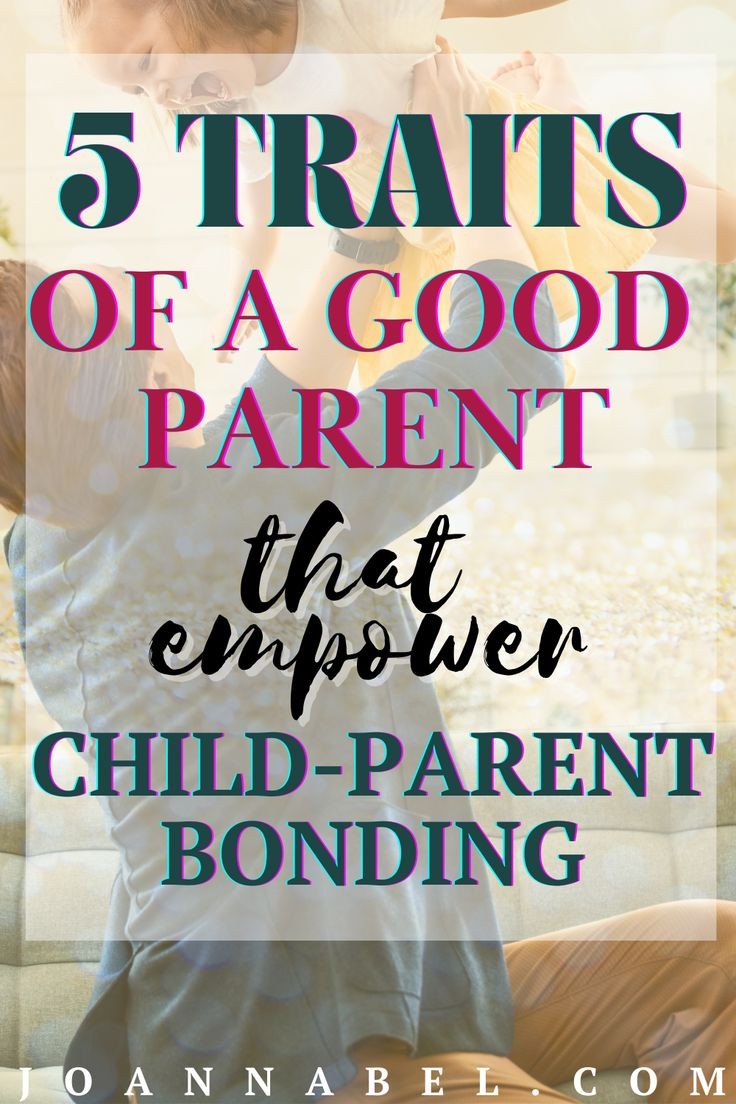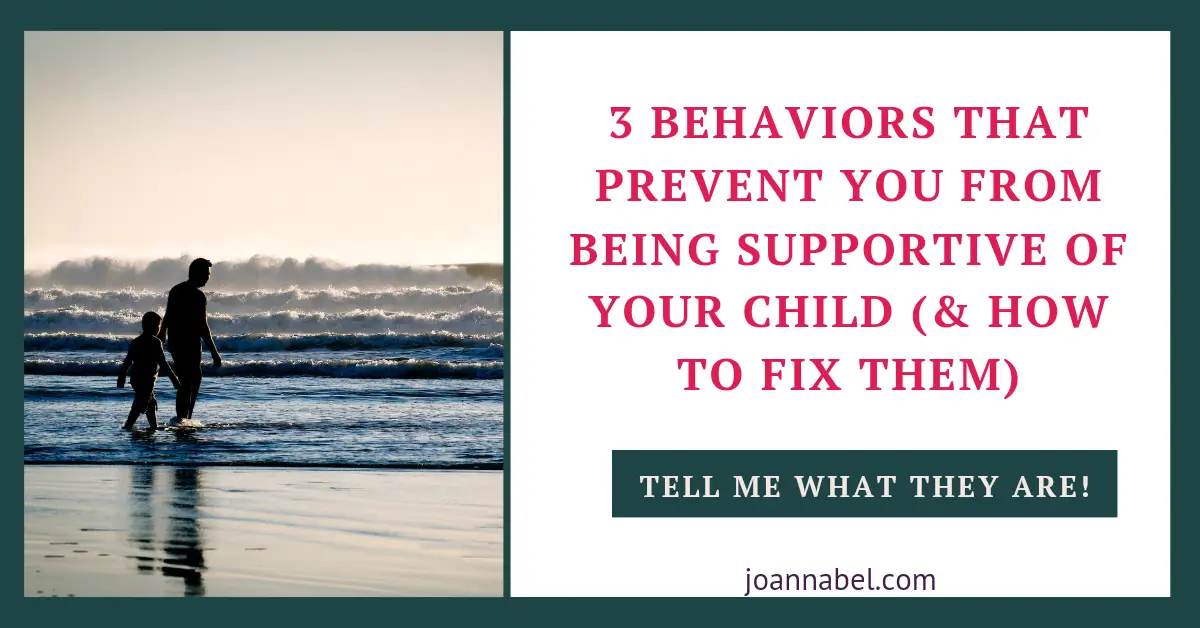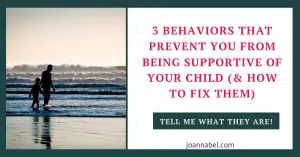If you want to know the 5 characteristics of a good parent this is exactly the place where you can uncover them!

5 Traits Of A Good Parent
These characteristics of a good parent consist of:
- being a responsive parent,
- cultivating the democratic parenting style,
- enabling and supporting child participation,
- obtaining a well-balanced structure and control,
- challenging kids to do their best.
Obtaining them will enable you to form a stronger bond with your child.
Considering that when you manage to meet the children’s developmental needs in this way, a child can thrive, be empowered, feel free and safe at the same time, and have your back to experience life in the most suitable way for them individually.
We’ll discuss each of them in this post, and I suggest that we start immediately!
Note: Although I am a Clinical Social Worker, engaging with this website does not establish a professional social worker-client relationship. The information provided here is for general purposes only and should not be considered professional advice. While we strive to ensure accuracy and reliability, this content is not a substitute for professional guidance. For specific concerns, issues, or situations, it is essential to consult a qualified professional and present your situation. Read the full Disclaimer here.
WHAT MAKES A GOOD PARENT
#1 A GOOD PARENT IS A RESPONSIVE PARENT
Responsive parenting is being attentive to the child’s emotional and other needs by developing a sensitive and sensible (perceptive) reception to what the child requires and providing a response suitable for the child’s developmental phase.
This means that to be able to respond optimally, you need to:
- Show empathy in your response – recognize their emotions, be receptive to the child’s emotions, and reflect them in your emotional response.
- Decenter – understand and acknowledge their point of view by separating it from your point of view (- to resonate with their way of thinking by separating from your way of thinking about the particular situation).
- And you also need to understand if the response is suitable for the child’s developmental phase.
So, when you are responsive as a parent you acknowledge a child’s unique position concerning positions of power within the family, dependence on adults, developmental stage, and skills a child acquired by that stage.
You show interest in the child’s perception (points of view) – and you consider it and their emotions. And you’re being respectful of their perception and their emotions.
In the simplest – with emotionally warm and responsive parenting, children are certain they’re loved, cherished, and respected enough as persons, as human beings.
The dimension called emotional warmth and responsiveness I’m mentioning here is one of the six parenting capacity dimensions.
Parenting capacity is the parent’s competence and capability to recognize the child’s needs, give them priority over their own, and respond to them in an empathetic way, in order to provide protection, care, and necessary conditions so a child can grow and develop.
If you’re curious about the dimensions of parenting capacity read my blog post that covers this in a lot more detail. Here is the link: What Is parenting Capacity And How To Find Balance As A parent.
Let’s continue with responsive parenting now. We should talk about why it’s important.
So, responsive parenting is important because this way you’re meeting the child’s need for safe, stable, and persistent connections and relationships with the close and significant adults in their lives. Those adults are responsive and sensible to the child’s emotional needs.
This means that when you are skilled at suitably meeting their needs, you will experience more balance in closeness and connection. But also, these relationships can thrive and children can thrive individually, too.
When I say emotional needs I mean the need:
- for closeness and emotional warmth
- for connection
- to be seen, acknowledged as worthy, and treated as worthy
- for appreciation of their individuality and visibility
- to be empowered and encouraged
- to be heard and understood
- to be reassured and comforted
- for having dependable, trustworthy, and reliable adults in their direct social environment
- to feel loved
- to be certain they have a responsible and competent parent
- to be guided and praised
- to feel respected, and worthy in situations when their identity intersects with age and maturity, race, religion, sexuality, disability, etc.
- physical touch they’re comfortable with.
- to feel autonomous and independent enough.
Parents are (or can become) more responsive toward their child if they achieve good-enough responsiveness, which assumes timely, consistent, suitable actions and activities directed and targeted to answer to the needs of the child.
But please note that this isn’t to be understood as parents meeting all the needs of the child at any moment all the time. This wouldn’t even be beneficial, but the point is that it isn’t possible, which all parents realize soon enough.
Parenting is situational. And we’re aiming for good enough and functional here, not for perfection.

If you notice that you’re being too protective, you should work on releasing the pressure you put on your children.
Too much protection sends a message that a child isn’t competent to do things on their own. And is denying them their power to claim agency in their lives.
If you want to put your warmth and responsiveness in perspective, you can use the next 4 indicators (adaptation based on Bentovim, et al, 2009):
- How much consistency you show in your emotional responsiveness as a result of the recognition of the child’s emotions
- How you evaluate and then respond to a child’s emotional tone
- What kind of tone you use in your communication with the child in general and what atmosphere you’re cultivating
- How supportive and engaged you are while managing to address the tension between independence and dependence in providing this.
And if you want to be emotionally warm and responsive, you:
1. need to show you care;
2. need to manage mistakes, misbehavior and punishment well (if you use punishments)
3. should be transparent with kids (age-sensitively)
4. should encourage freedom, inclusiveness, and participation.
For more information about responsive parenting, you can read my blog post What Is Responsive Parenting + Signs Of Emotional Warmth.
You should also check out:
#2 A GOOD PARENT CULTIVATES THE DEMOCRATIC PARENTING STYLE
Parenting style refers to the consistent and stable patterns of demands, structure, and responsiveness that parents cultivate in all of their interpersonal interactions with their children. The parents’ practices are dependent on these patterns. That’s why it’s called style – it is perpetual and it’s resistant to events, situations, a child’s age, and developmental phase. This doesn’t mean that it’s unchangeable, it only means that it is constant and consistent.
Democratic or authoritative parenting is the most desirable style from the standpoint of the developmental needs of a child.
This style characterizes moderate to high relational closeness, and moderate to high flexibility, which is optimal for family relations and the kids.
More precisely, this means that these parents achieve balance with closeness and with flexibility.
Let’s break this down. These relationships have balanced closeness, which means they’re not too close or disengaged.
Too close relationships create enmeshment and too little connection creates disengagement. Both of these extremes aren’t optimal for family functioning and can become pretty unhealthy.
When it comes to flexibility these parents nurture balanced flexibility, which means they are not providing too much (excessive) structure, not they’re too lenient and permissive.
Too much structure creates rigidity in the relationships, while too little structure and lack of boundaries induce chaos. Both of these aren’t optimal for a family to be functioning well and can become pretty unhealthy too.
The problem isn’t that they’re only unhealthy, but they obstruct parenting from being effective. And can negatively affect the socio-emotional maturity, behavior, and development of children.
The other 4 parenting styles all have different combinations of unbalanced structure or unbalanced closeness of the relationships, but I won’t get into this in this post.
You can read about it in my post that covers 5 Parenting Styles in detail: What The 5 Parenting Styles Are: All You Wanted To Know.
You may want to check out the post that cover different parenting styles:
- AUTHORITATIVE PARENTING: CHARACTERISTICS AND EFFECTS THAT MAKE IT THE BEST STYLE
- 10 BENEFITS OF AUTHORITATIVE PARENTING: FOR PARENTS AND KIDS
- 5 PARENTING STYLES AND RULES
- WHAT IS THE PERMISSIVE (LAISSEZ-FAIRE) PARENTING STYLE AND ITS CHARACTERISTICS AND EFFECTS?
- WHAT IS THE REJECTING PARENTING STYLE AND ARE YOU A REJECTING PARENT?
- AUTHORITARIAN VS. AUTHORITATIVE PARENTING
- WHAT IS AUTHORITARIAN PARENTING STYLE AND WHO ARE AUTHORITARIAN PARENTS?
- WHAT UNINVOLVED PARENTING REALLY IS AND WHO UNINVOLVED PARENTS ARE (NEGLECTING PARENTING)
Moving on. Parents with a democratic parenting style are emotionally warm and responsive. Considering we talked about this dimension of parenting capacity previously, we can skip ahead.
They’re good at balancing control and structure, consistent with discipline, and they support the child’s autonomy in decision-making. This is due to their encouragement of children’s independence, with proper monitoring.
For more about how to help a child become more independent, read my blog post that covers this. Here is the link to it.
So, they’re consistent and fair with implementing disciplinary measures, while being skilled at establishing clear rules and clear expectations which they discuss with the child to make sure the child understands.
They are being open to negotiating with the child. As well are open to the child’s participation in decision-making about the things that affect the child. And reconsidering their own opinions or decisions.
However, this doesn’t mean they’ll share their responsibility for guiding a child with the child, or that they’re not in charge. It simply means they respect the child’s autonomy especially as the child becomes more and more mature.

If you happened to be confused about the term guidance or the purpose of guidance from parents I have a blog post on this topic.
So they care about the child’s perspective and they share the power with the child in this way. But with putting their standards into effect.
And this is the key point why this is considered effective parenting. This way children always know where the boundaries are. What they need to do or where they’re headed.
While at the same time they don’t feel powerless. That’s because they’re sure their parents will always hear and see them.
This means that besides clear rules and expectations, the roles (parents and child) are clear too and they’re not intertwined.
If f you want to focus on democratic parenting, then read Authoritative Parenting: Characteristics And Effects That Make It The Best Style and 10 Benefits Of Authoritative Parenting: For Parents And Kids.
#3 A GOOD PARENT ENABLES AND SUPPORTS CHILD PARTICIPATION
Participation is a very broad topic, but let’s point out the most important things to note.
Child participation refers to:
- One of the 4 basic principles of the CRC (Convention On The Rights Of The Child from 1989), along with (1) the principle of life, survival and development, (2) the principle of non-discrimination, and (3) the principle of the best interest of the child.
- The specific article of the CRC (article 12 of the Convention On The Rights Of The Child).
- A group of participating rights.
Let’s explore it in more detail so it’s more clear.
When it comes to this list, in the first place, this means that we need to stick to these 4 principles in all our encounters and treatments of children.
Secondly, it’s important to know that the principle of participation and best interest are interconnected.
The first involves the active role of the child and acceptance that children should present their views and experiences, as a basic condition for the decision-making process to satisfy the second, i.e. the best interest of the child.
Thirdly, Article 12 states that the child who is capable of forming his or her own views has the right to express those views freely in all matters affecting the child, with the views of the child being given due weight in accordance with the age and maturity of the child.

Research showed and it’s clear that children can express their views from their earliest age, but the nature and range of their participation will continue to widen according to their age and evolving capacity.
As they mature their perspective and views will expand and they will be entitled to have their participation in decision-making affect the outcome of a wider range of matters that impact them.
When you’re supporting and enabling children to participate, keep in mind that they don’t need to be able to understand all aspects of the matter to the full extent.
It’s enough that they can attain enough understanding of the matter to be able to form an opinion on the matter and give their contribution.
And finally, the participating rights. They are:
- the right to the freedom of expression (Article 13),
- the right of the child to freedom of thought, conscience, and religion (Article 14),
- the rights of the child to freedom of association and freedom of peaceful assembly (Article 15),
- the right to the protection of interference or attacks on their privacy, family, home or correspondence, and their honor and reputation (Article 16),
- the right to access to information (Article 17), and
- the right to an education that promotes values of human rights and democracy (Article 29).
You can find the articles here: Convention on the Rights of the Child.
The process of participation involves:
- creating space for children to express their opinion and active listening to children, which indicates that adults perceive and respect that children have the experience in their own life situations and have something to say about things that are important for their life and optimal development.
- acknowledging and respecting the opinion of the child – in each individual case it is necessary to take into account the age of the child, the evolving capacity of the children to participate in decision-making, and the maturity that children show as factors in the impact on the decision.
- the responsibility of adults to find a way for children to meaningfully participate in the decision-making process on all issues concerning them.
This certainly does not mean that children will be in a position of full autonomy (burdened with it), nor that full unilateral control over the decision-making process will be transferred to them, precisely the independent decision-making process.
Children in such a conceived process will not take over the decision of the adults.
But will have their inalienable right (the right that can’t be transferred to ANYONE else) to be heard and consulted exercised.
And will satisfy their need to express their point of view and share their experience, if they wish, so they can achieve a sense of control over personal events and influence the outcomes of all actions that are of importance to their lives.
You’ll find useful also:
- 100 Ways To Be Kind To Your Child
- How Should Parents Treat Their Children If They Want Their Children To Be Their True Selves
- 19 Signs Unsuportive Parents Show
- 9 Biggest Mistakes Parents Make
If you found the information on the blog helpful & inspirational and you feel like giving back, you can do it by clicking the donate button after entering amount you’re comfortable with. I’ll use it to create and deliver more useful content and resources like this. Thanks for your precious contribution!
#4 A GOOD PARENT OBTAINS A WELL-BALANCED STRUCTURE AND CONTROL
With well-balanced guidance, you’re in charge and you’re guiding the way and kids know that and count on it, and this is why you have control over the situation.
This means that the focus isn’t on controlling the child nor will that be such an important topic in your family life once you find the right balance with guidance.
Guidance is a dimension of parenting capacity that we can define as the way parents teach, assist and enable a child to manage their emotions and behavior which they’re doing by:
- regulating and shaping the behavior with a set of limitations and boundaries aimed to get a child to establish an internal model of moral values, develop a conscience, learn socially and culturally acceptable behavior, and
- by directly demonstrating and modeling prosocial behavior, balanced emotional regulation and expression, and socially acceptable and respectful interpersonal interaction.
But if you don’t, kids aren’t counting on it and they’re self-regulating the way they can. And this isn’t that self-regulating that you want, where they are gradually learning to manage their emotions and behavior.
For instance, they could start with hiding their needs so they don’t upset the parent who doesn’t respond well when they (children) are in distress.
The fact is that they start to pick up that if they show distress then the parent is prone to leaving them behind, which is why they will change their behavior so they convince the parent to respond to them.
I know this might be unsettling to hear, but it’s important to talk about these things. Kids ”know” to what extent they can rely on you even in the first months of their lives. And this is reflected in the affective attachment between a child and a parent.

With a Secure attachment between the parent and the child, the children know they can securely rely on the parent to meet their needs. While with an Insecure or Disorganized attachment that’s not the case.
Here a child knows exactly what and what not to expect from the parent and then the child’s behavior is a result of their attempt to ‘’persuade’’ a parent to respond to their needs. Because in this situation a parent lacks the skills to respond in a way that fits the child’s needs.
Keep in mind that it’s essential to be consistent with structure and guidance.
The structure you’re providing should be consistent so that is familiar to the child and the rules and expectations should be clear and consistent, not changed often.
If not, a child can have trouble catching up with rules and expectations.
Question if the rules:
- are too strict,
- are too loose and prone to being easily manipulated,
- are unclear,
- change too often,
- are inappropriate by nature considering child age or in general.
And in situations when the rules aren’t followed there should be a logical and suitable, non-reactive and non-violent response.
This doesn’t have to be punishment, moreover, it’s important not to focus on them, especially on harsh mannered punishment because they can be harmful. (If you need a resource to help you use punishment safely read my post about it or get the resource I create for you: 10 Rights And 10 Wrongs When Implementing Punishment As A Response To A Child’s Behavior.)
What’s also important is that children know what’s expected of them and that they get proper feedback for their actions. But respond in a balanced way instead of a reactive one. Obviously, it’s not possible to hold it together all the time, what counts is the average or the patterns.
The inflexible structure will soon become ineffective, but also potentially toxic at one point. Because without flexibility, the relationships are destined to get corrupted.
This means that if you want to have strong emotional bonds, and a connection that is suitable and comfortable for all parts included, you need to nurture flexibility.
Don’t worry, flexibility doesn’t mean that you’re too soft or a pushover – that would be then called being permissive. So, feel free to cultivate flexible boundaries, and take an assertive approach.
To be assertive means that you stay strong with your request towards a child that is benefiting their well-being but kind and soft with treating them. This means that you don’t need to make them feel excluded to make them follow your request.
Moreover, if you can include them in the process so they have a saying in some way, or if you make an agreement with them (it’s important that they see and trust that you are making an agreement with them and respecting them) you will have less trouble with their complying.
The need to participate in things that affect us is an inherent need for any human, so don’t deny it to your kids.
Do the exact opposite – leverage this to the maximum, this can make your life so much easier!
Now, I encourage you to look at the misbehavior:
- from a perspective of its meaning (put effort into understanding it, avoid reactive response as much as you can),
- if it’s repetitive (a pattern or situational, as well as if their pattern is in relation to your guidance),
- if it’s actually logical that it occurred so it’s not misbehavior it’s a regular response to the conditions (reconsider your conclusions, especially if they came too soon),
- and if it’s positive it happened (a too obedient child is often a red signal and warning for you that a child is frightened of opposing).
So what I’m saying is to keep an open mind and question things. And don’t punish your children because of their emotions. Help them manage their emotions.
What will always be very helpful with anything that’s going on, is working on the communication within the family and with your kids. So communication is often the cause and the solution to the problem.
I have child guidance resources you can check out to get more information on how to obtain well-balanced guidance. They are:
- Guidance From Parents: What Is It In Child Development
- Child Guidance: 12 Questions For Parent Self-Evaluation
- Child Behavior Management: 12 Signs You’re Crazy Good At It
- What is Positive Child Guidance and Why is it Important?
- How To Set Rules For Kids The Best Way.
If you found the information on the blog helpful & inspirational and you feel like giving back, you can do it by clicking the donate button after entering amount you’re comfortable with. I’ll use it to create and deliver more useful content and resources like this. Thanks for your precious contribution!
#5 A GOOD PARENT CHALLENGES KIDS TO DO THEIR BEST
When kids are challenged to do their best, they are motivated to progress, learn, and develop to their full potential.
To accomplish this, you need to provide a solid structure and maintain high expectations. The best way to achieve this is to support them and reward their good efforts. But it’s also important to allow enough time for play and enjoyment.
Parents can help their children reach their full potential by:
- Being emotionally warm and responsive.
- Showing support.
- Being present.
- Establishing clear rules and expectations.
- Putting effort into understanding a child’s behavior. Point out and praise good behavior and deal with misbehavior nonviolently.
- Assisting children in integrating their life experiences.
- Focusing on reparation instead of retribution. But if you’re using punishment, be fair and righteous and never vindictive, cruel, or harmful.
I wrote a full blog post that covers these positive parenting rules you should stick to if you want your children to reach their full potential. Here is the link: How To Help A Child Reach Their Full Potential – 7 Positive Parenting Tips.

What can come as an obstacle in your efforts to help your children do their best and reach their full potential is the urge for protection. The urge to protect them.
It’s never easy to challenge them when we see that they’re at unease or even hurting, even when this pain is good for them because it’ll teach them to not give up easily in life, for instance.
But as you know being perfectly safe can’t help us grow and expand while taking or experiencing no risks in life affects the quality of that life.
If we’re only staying in our zone of comfort we won’t make much progress.
This is why it’s important to support children’s intrinsic curiosity. And to challenge them and set high expectations.
This doesn’t mean demanding perfection or being too hard on them. It’s important to show support and appreciation for their efforts to keep them going.
What’s important here is to simply exercise this. It will be easier with practice.
What’s critical is having their back. Encourage, motivate, and help them master doing things on their own.
Carefully correct them as well as let them fail too, so they can learn from their mistakes and then become better.
This suggests you shouldn’t be discouraging and overly criticizing because you don’t really want them not to try or to stop trying, to fear failure excessively, and to feel paralyzed to experience new things.
And this will help them explore life and life’s possibilities more, become more independent, be authentic, and ”find themselves” faster.
To continue exploring this topic, I suggest that you read my posts:
- How To Help Your Child Reach Their Full Potential – 7 Positive Parenting Rules and
- How To Help A Child Become More Independent – 9 Principles To Follow. Or my post How To Be A Supportive Parent You Truly Desire To Be.
Latest Posts:
- Special Gifts to Let Someone Know You’re Thinking of Them (13)

- 100 Ways to Challenge Yourself (Without Stretching Yourself Too Thin)

- What To Do When Your Parent Struggles With Alcohol

- How To Navigate Moving to a New Home With Your Kids

- Prenups for Young Couples (A Modern Approach)

- What Happens When You Sign A Prenup (Relationship-Wise + Legally)

FINAL THOUGHTS ON WHAT DEFINES A GOOD PARENT
And that’s all there is! Those were the 5 virtues of a good parent that will empower child-parent bonding. Let’s repeat what they are:
- Nurturing responsive parenting.
- Attaining a democratic parenting style.
- Including and practicing participation.
- Keeping well-balanced structure and control.
- Challenging children to do their best.
Keep them on top of your mind and do what you can to achieve them or maintain them in your family life.
And if you find this post helpful, share it with others whom you believe will get benefit from it.
See you in my next post! Here is one:

Related:








